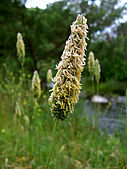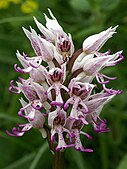Tinanom na namumurak
An mga tinanom na namumurak iyo an mga tinanom na nagdadara nin mga burak asin prutas, asin minabilog sa clade na Angiospermae (/ˌændʒiəˈspərmiː/),[5][6] komun na pig-aapod na angiosperms. Kabali sa sainda an gabos na forbs (mga tinanom na namumurak na mayo nin makahoy na paglang), duot asin mga tinanom na garo mga duot, sarong mahiwas na mayorya nin broad-leaved trees, shrubs asin balagon, asin kadaklan na akwatikong tinanom. An terminong "angiosperm" ginuno gikan sa Greek words ἀγγεῖον / angeion ('container, vessel') asin σπέρμα / sperma ('pisog'), nangangahulugan na an mga pisog nakapalaog sa sarong prutas. Sinda sa ngunyan an pinaka-diverse na grupo nin mga tinanom sa daga na igwa nin 64 orders, 416 families, pigtantya na 13,000 na midbid na genera asin 300,000 na midbid na espesye.[7] An mga angiosperms dating inapod na Magnoliophyta (/mæɡˌnoʊliˈɒfətə, -əˈfaɪtə/).[8]
| Tinanom na namumurak | |
|---|---|
| Sayantipiko na klasipikasyon | |
| Kahadean: | Plantae |
| Klado: | Spermatophytes |
| Klado: | Angiosperms |
| Groups (APG IV)[1] | |
| |
| Sinonimo | |
Angiosperms are distinguished from the other seed-producing plants, the gymnosperms, by having flowers, xylem consisting of vessel elements instead of tracheids, endosperm within their seeds, and fruits that completely envelop the seeds. The ancestors of flowering plants diverged from the common ancestor of all living gymnosperms before the end of the Carboniferous, over 300 million years ago. In the Cretaceous, angiosperms diversified explosively, becoming the dominant group of plants across the planet.
Agriculture is almost entirely dependent on angiosperms, and a small number of flowering plant families supply nearly all plant-based food and livestock feed. Rice, maize, and wheat provide half of the world's calorie intake, and all three plants are cereals from the Poaceae family (colloquially known as grasses). Other families provide materials such as wood, paper and cotton, and supply numerous ingredients for traditional and modern medicines. Flowering plants are also commonly grown for decorative purposes, with certain flowers playing a significant role in many cultures.
Saro sa "Big Five" extinction events sa kasaysayan kan Kinaban, solamenteng iyo an Cretaceous–Paleogene extinction event an nangyari mantang an angiosperms iyo an nagdominar na buhay tinanom sa planeta. Sa ngunyan, an Holocene extinction naapektuhan an gabos na mga kahadean nin komplikadong buhay sa kinaban, asin an conservation measures iyo an kinakaipuhan tanganing protihiran an mga tinanom sa saindang habitats sa wild (in situ), o failing that, ex situ sa seed banks o artipisyal na habitats siring kan mga [botanikong tatamnan]]. Otherwise, around 40% of plant species may become extinct due to human actions such as habitat destruction, introduction of invasive species, unsustainable logging asin koleksyon nin medicinal o ornamental plants. Further, climate change is starting to impact plants and is likely to cause many species to become extinct by 2100.
Toltolan
baguhon- ↑ APG 2016.
- ↑ Cronquist 1960.
- ↑ Reveal, James L. (2011). "Indices Nominum Supragenericorum Plantarum Vascularium – M". Archived from the original on 27 August 2013. Retrieved 28 August 2017. Unknown parameter
|orig-date=ignored (help) - ↑ Takhtajan 1964.
- ↑ Lindley, J. (1830). Introduction to the Natural System of Botany. London: Longman, Rees, Orme, Brown, and Green. xxxvi. Archived from the original on 27 August 2017. Retrieved 29 January 2018. Unknown parameter
|url-status=ignored (help) - ↑ Cantino, Philip D.; Doyle, James A.; Graham, Sean W.; Judd, Walter S.; Olmstead, Richard G.; Soltis, Douglas E.; Soltis, Pamela S.; Donoghue, Michael J. (2007). "Towards a phylogenetic nomenclature of Tracheophyta". Taxon 56 (3): E1–E44. doi:.
- ↑ Christenhusz, M. J. M.; Byng, J. W. (2016). "The number of known plants species in the world and its annual increase". Phytotaxa 261 (3): 201–217. doi:. https://biotaxa.org/Phytotaxa/article/download/phytotaxa.261.3.1/20598. Retrieved on 21 February 2022.
- ↑ Takhtajan 1980.





